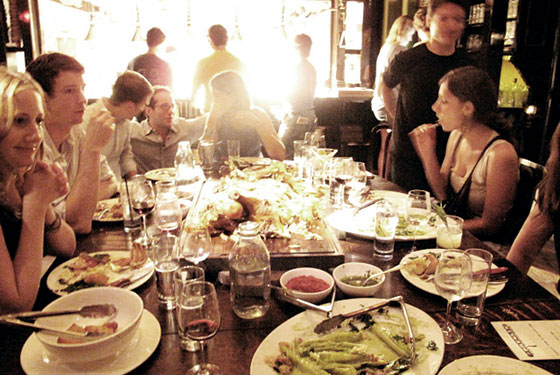
It’s four o’clock on a Thursday in the barroom of the Breslin, a grand meaty pub with animal heads and medieval chandeliers. A man in his forties appears to be interviewing a brunette in her early twenties. He has a résumé in his hand and every time she looks down at her red wine he looks at her chest.
“My mom goes on ten-mile walks every day,” she is saying, “so I understand commitment.”
Beside them, a young man with a popped collar reads the new William Gibson over a Guinness. A blonde in pearls and a man in a suit sit across from each other at one of the communal bar tables, their laptops back-to-back like a game of Battleship.
The Breslin, opened last year in the terribly cool Ace Hotel, is the fatter, vested brother of the Spotted Pig, run by the same snout-and-jowl duo, Ken Friedman and chef April Bloomfield. In the span of just seven years, Bloomfield has helped change the way we eat—in bars, without tablecloths, with fatty ales and laptops for friends, relentlessly local, laid-back and coolly casual but still epicurean and expensive.
Inside the Breslin’s kitchen it’s breathlessly hot and smells like fresh sausage. A pig’s foot swivels heavily in a pan, waiting for its local radishes. Pools of fat bubble inside curling tongues of bacon. A tattooed redhead is screaming orders. Another gruff girl shouts, “Give me your Microplane please, right now! Right now!” as though this were an adventure film and the Microplane is the rope off the edge of the cliff.
Among the punk soldiers in white coats, Bloomfield is quietly tossing a kale salad. Wearing loose jeans, clogs, and no makeup, with her strawberry hair in a bun, she floats around the room, tasting things quickly and unobtrusively, like a squirrel. She tops the lamb burgers with their sourdough hats, plucks fries from one tin and bequeaths them to an order with less. As her soldiers yell and shuffle and grate the life out of a wedge of Parmesan, Bloomfield is serene and diligent and almost meek, as if she were not the woman they are all trying to please.
Legend goes that when Ken Friedman was looking for a chef to helm the Spotted Pig back in 2003, he enlisted the help of his friend Mario Batali. Batali told him if that Bloomfield was the right person for the job, he would be able to tell him so in ten minutes. The two men took Bloomfield on a food tour of New York, from pizza to dumplings, and sometime in between Batali gave Friedman a thumbs-up behind Bloomfield’s back.
“I was excited and nervous and I didn’t know who Ken was, I didn’t know who Mario Batali was,” Bloomfield says. “We ate a lot of food but we didn’t talk about cooking too much. Mario looked at the burns on my arm and I guess he thought I was a tough cookie.”
Bloomfield had planned to be a policewoman in Birmingham, England, until she didn’t get her application in on time. Thanks to that bit of tardiness, she instead decided to follow her two sisters into cooking, working her way up the line in restaurants around London. She worked for Ruth Rogers and the late Rose Gray at London’s River Café and later spent a summer with Alice Waters at Berkeley’s Chez Panisse. But when fellow Brit and River Café alumnus Jamie Oliver recommended her to Friedman, she was still a relative unknown. Her debut at the Spotted Pig drew a lot of attention—not just because of the involvement of Batali and several high-profile investors (Bono and Jay-Z), but because Bloomfield was running a new kind of restaurant that brought together several foodie threads: serious snout-to-tail cooking with a religious adherence to fresh/local/seasonal ingredients, served in a casual atmosphere with a tone of clubby downtown cool. As Anthony Bourdain puts it: “She pretty much wrote the all-time book on how to come from someplace else and make New York love you.”
Bloomfield’s cookbook, A Girl and Her Pig, comes out in 2012, but beyond that and a few odd interviews and TV appearances, she keeps her head in her pots. She’s in the kitchen at the Pig on some nights, the Breslin on most others, and getting the new John Dory Oyster Bar (also in the Ace) ready for opening in early November. She also maintains a food-exchange program with father of head-to-tail eating Fergus Anderson of St. John—they switch spots on occasion to keep up with each other’s shore.
“She’s never worked the room, she’s never played the game,” says Bourdain, “and yet everybody knows who she is—she’s one of the only high-profile chefs who’s almost never on TV, she rarely gives interviews, and every time I walk into the Breslin or the Spotted Pig, I look back there and she’s standing behind the line, actually cooking.”

Her actual cooking is marked by careful study of French and Italian classics but with an infusion of the trotters and things she grew up with, so that she ends up taking some thick British beasts and coddling them in delicate pea shoots and springy beans. Take, for example, the epiphany she had at the River Café, which involved a walnut pasta that was so damn simple—just lots of fresh seasonal stuff—but that taught her you don’t need to do a lot if you have great ingredients. “It was the most amazing thing I’d ever eaten. It was like someone had hit me in the head with a great pan,” she says. “It shocked me into another palate level, and it made me question what I had been doing for the last ten years.” She wanted to re-create that feeling for her diners.
Hence, the Breslin’s Caesar salad. The romaine is crisp and the flavor is tart and bright but also deep and pleasingly fishy. It is nothing shocking—even though overenthusiastic patrons will say it is—but Bloomfield is not out there to make things that shock. She is more interested in the simple pleasures of a great mouthful. “There is something about someone making a fantastic sandwich,” she says, “taking care to spread lots of mayo all the way to the edges. Making sure every bite has a bit of everything in it. There’s something special about that.”
On a Friday morning in early fall, as Union Square shakes off the city and becomes a harvest wonderland, Bloomfield is weaving through the stalls, seeing what looks good and ripe and cool. After a run-through, she texts her foragers and tells them what to buy. She stops to take a picture with her iPhone of a beautiful clump of lavender. Then a mass of strawberries. “All chefs have pictures of food in their phones, stuffed pig’s ears and pigs’ heads and the like,” she says.
At Berried Treasures, her favorite stand, she runs into one of her pigtailed foragers. These is a coterie of young people with backpacks and bicycles who find fresh local produce and bring it to her like offerings to a queen. Before Bloomfield, and chefs like her, these kids might have been shelving books at the Strand, or caressing vinyl at Kim’s Video. Now they will bike back to the far reaches of Brooklyn with their newfound food acumen, and an obsession with mustard greens will be spread like indie music.
Here comes Scott, who has been charged with looking for a swath of farmland in upstate New York or New Jersey so Bloomfield can grow her own produce. It’s all part of the ongoing race to do everything yourself, to grow tomatoes as close as physically possible to where you cook them. If they could, chefs would plant seeds in their wrists so they could web-sling marjoram directly into their cast-iron pans.
At the next stand, where Bloomfield is impressed with the green vibrance of peppers, she runs into Trevor, a chef of Blue Hill. He’s wearing a Prosciutto e Uova Verdi T-shirt, and vaguely they acknowledge their roles in the restaurant firmament. This is the yawning early-morning conference call, when the food aristocracy comes to snap off a husk cherry and determine its debut in a salad tonight, and then later, its sudden manifestation in the collective food brain. Soon, bearded Park Slopers and Lululemon’d Upper West Side mothers will chant to the overwhelmed shelvers in their local Whole Foods: husk cherry, husk cherry.
Bloomfield’s favorite season is fall and she loves the sight of a good squash. Gourds! She loves gourds, such an American cuteness. And that over there, on flagrant display like Wilbur at the fair, is what Bloomfield refers to as a puff ball. It’s a mushroom the size of a human head, which she has never seen in this country. “I’m so excited,” she says, and she bends down to smell it, press it, love it. She sticks her fingers in its deformed holes like she’s going to bowl it.
At home on the East Side, Bloomfield has a fat cat. In the morning, she drinks tea and comes up with new recipes. “Because it’s in the morning that I’m usually quite hungry, and my ideas come easier when I’m hungry. It’s the best time to write a recipe.”
Fidgety when she is in a seat talking about herself, Bloomfield has a typical British reserve, and lately she has gotten a bit sensitive to being characterized as the offal chick, the woman splaying a pig into its many comestible parts. Pig’s feet and pig’s ears aren’t on her menu because they’re trendy, she says, but because that’s what she grew up with.
But for all her not trying, she has changed the way we dine. “We were desperate for the gastropub experience,” says Barbuto chef Jonathan Waxman. “It’s such an English sensibility, to drink beer and eat at the bar, but they had crappy food forever and suddenly all these young chefs wanted to fix things. But it was April who really understood it. It was April who brought it to America. And she did it with American ingredients, which is the coolest thing.”
She also did it as a woman, which is quite unusual. It’s easier for women chefs to go into pastry than pig’s ears. She has had problems with men in the business taking her seriously. But things have been changing. Batali announced her and anointed her. Jean-Georges Vongerichten, who lives a few blocks from the Pig and makes it his 2 a.m. stop when he’s forgotten to eat, says, “The fries with rosemary are to die for. Sometimes, I wake up in the middle of the night thinking of them.” And Waxman says, “I love that woman more than you know.”
If there is a gentle condescension to the way male chefs talk about her—the sweet offal girl who runs the place at which the terribly serious male chefs can get some fries late at night—she doesn’t let it get to her. Not a lot does. Bourdain says she’s so good that “she can get away with running the hottest restaurants in town.” He means that coolness can detract from the food, but she is too uninterested in the perks of running a hot restaurant to let that happen.
Back in the barroom, it is six o’clock. The man in his forties and the girl in her twenties have fingered their way to the bottom of a bowl of boiled peanuts fried in pork fat. As they get up to leave, the young girl signs the bill and takes the older man’s résumé, and she thanks him for his interest.